Unlock your payables data with AP dashboards
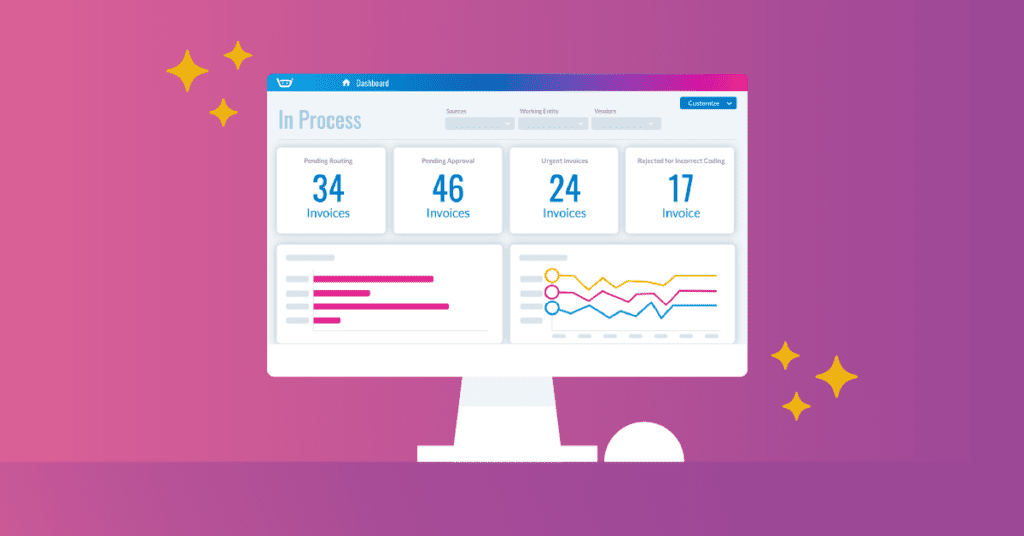
Would you like deeper insights into your AP processes so you can make data-backed decisions?
You already know that when accounts payable is running at peak efficiency, your entire business benefits. You can manage cash flow to ensure you have working capital, pay vendors on time to maintain good relationships and monitor invoice processing efficiency to control costs.
Unfortunately, many CFOs and controllers rarely have visibility into the nuts and bolts of accounts payable departments. Without this knowledge, tracking KPIs and spotting bottlenecks can be difficult. And if you’re in the dark about your AP metrics, you may be leaving money on the table.
Comprehensive accounts payable dashboards are an excellent way for finance leaders to monitor department performance, analyze problems, and keep tabs on key metrics. Dashboards provide real-time visibility and insights into your invoice processes and transactions – and let you drill down into the data when you need to know more.
In this article, we’ll discuss the wealth of information accounts payable automation puts at your fingertips. Let’s explore how AP dashboards give you detailed, actionable metrics you can use to make informed business decisions and increase profitability.
What are AP dashboards?
Like the dashboard in a car, AP dashboards provide real-time information you need to monitor AP processes and transactions and keep things running smoothly. AP dashboards display key performance indicators (KPIs), alerts, trends, and metrics that show the health and performance of your accounts payable processes.
For example, at a glance, a dashboard could provide a CFO with business intelligence such as:
- Total accounts payable
- Outstanding payables and due dates
- AP employee workload reports
- Monthly/quarterly spend by department
Armed with this information, you can make informed business decisions, such as forecasting available working capital, prioritizing bill payments, implementing AP automation to reduce employee workloads, or optimizing procurement processes to reduce departmental spending.
What do AP dashboards track and measure?
Most accounts payable dashboards track transaction details and invoice processing performance metrics. This includes KPIs and visualizations like an invoice aging chart, invoice lifecycle, vendor information, error rates, and approval times. By keeping these metrics in front of the right people, dashboards ensure total transparency and visibility of the AP process.
Who uses AP dashboards?
AP dashboards provide useful information to anyone in the finance or accounts payable department. More specifically, it depends on the size of your company and how your finance department is organized. For example, a large enterprise may use different AP dashboards for different roles, each with the appropriate level of detail for its audience.
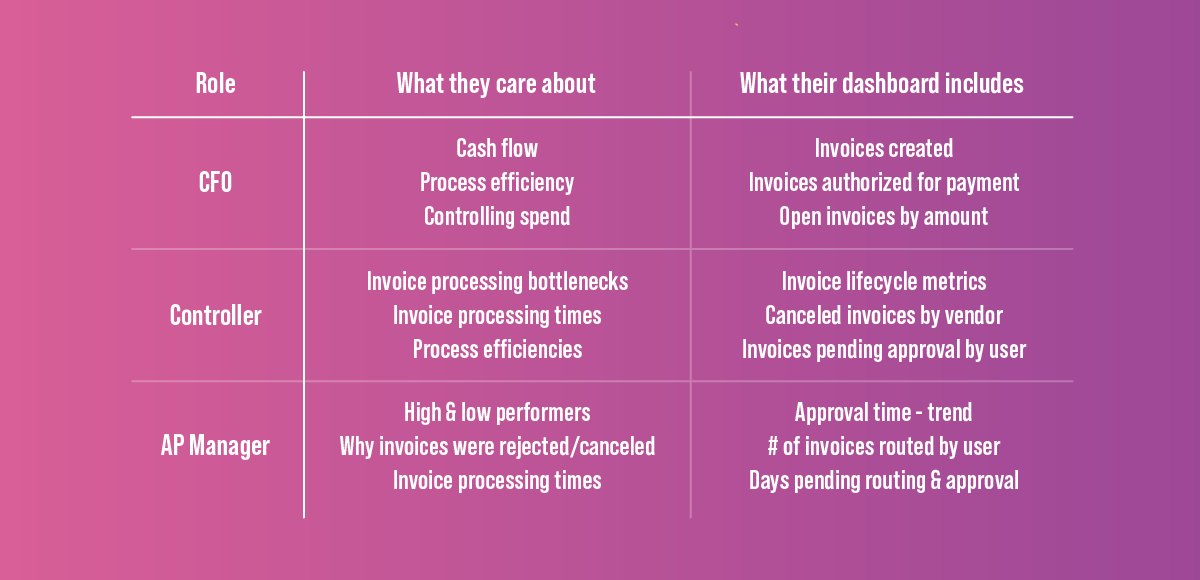
Benefits of AP dashboards
Tracking AP department performance is more important than ever.
Slow invoice processing can cost your business big, and the problem isn’t going away anytime soon. In Stampli’s 2023 survey, AP in 2023: Expectations, Technology, Opportunity, 80% of respondents said they expect the number of invoices processed to increase in the near future. In the same survey, 53% of respondents said they expect the complexity of invoices to increase as well.
Traditionally, companies have used many methods to track AP metrics, including Excel spreadsheets, account software, and even paper ledgers. However, an AP dashboard that’s integrated with an accounts payable automation solution provides significant advantages over these methods. Here are some of the key benefits:
Continuous real-time data visibility
Dashboards show real-time information and KPIs drawn directly from the AP automation system as invoices are being processed. Access to timely insights lets you stay on top of expenditures, make decisions, and manage budgets.
Deep productivity insights
By enabling you to dig deep into performance metrics, dashboards help you identify and mitigate bottlenecks to improve processing efficiency and resource management.
Better control over spending
Dashboards provide actionable, real-time aging and vendor balance data. You can use this data to optimize working capital by gaining tighter control over spending and cash flow management.
These benefits enable better use of human resources, stronger vendor relationships, and a healthier bottom line for your business.
With these benefits in mind, let’s look at the three most important AP dashboards in your toolbox. We’ll use a fictional company, CuddleCases, to help illustrate how each of these can benefit your business.
Types of AP dashboards
I’m the CFO of CuddleCases. We manufacture smartphone cases that people can personalize with a picture of their beloved pet.
Our business has experienced rapid growth, which has brought on a new challenge – we’re falling behind on paying our vendors. Because we make cases for dozens of different smartphone models, we work with a large number of suppliers.
As our business grows and the number of phones on the market expands, we’ve added new vendors. This has increased our invoice volumes. We’re considering implementing an AP automation solution to help streamline our invoice processing workflows. As part of the solution, we’d also like to improve visibility into our invoice processing and payments efficiency via AP dashboards.
The ideal solution will provide three main types of AP dashboards:
- Invoice Lifecycle Dashboard
- Invoice Processing Dashboard
- AP User Productivity Dashboard
Let’s look at each one.
Invoice lifecycle dashboard
The invoice lifecycle is the period of time from when AP receives an invoice to when it’s approved. It’s a key indicator of invoice processing efficiency. We can use the invoice lifecycle dashboard to monitor the total number of invoices created in the reporting period, the number of approved and rejected invoices, the top reasons for rejecting invoices, and the average time an invoice is in processing. These metrics will help us closely monitor AP workloads and identify bottlenecks in our process.
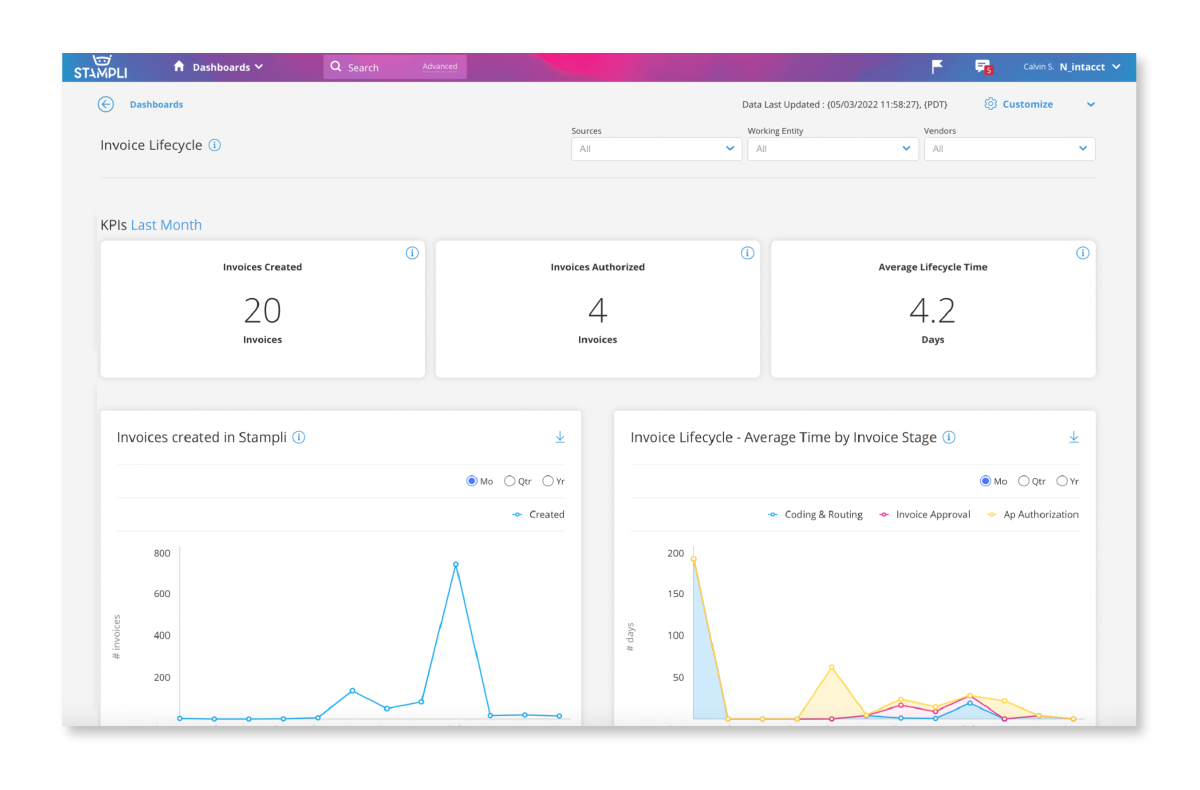
Invoice processing dashboard
The Invoice processing dashboard lets us measure invoice processing metrics such as:
- Number of unpaid invoices pending routing or approval
- Number of days open invoices remain in approval queues
- Number of urgent invoices
- Number of rejected invoices
This dashboard complements the invoice lifecycle dashboard by providing deeper insights into invoice workflows. It lets us zero in on our invoice processes to see where delays or errors occur.
For example, suppose we notice a high level of rejected invoices. In this case, we can use the invoice processing dashboard to investigate if vendors are sending erroneous invoices or if we are making errors checking invoices against purchase orders.
The invoice processing dashboard also helps us understand AP workloads. If the number of invoices pending routing increases each month while processing times get longer, it could be a sign our accounts payable team is getting overwhelmed by the volume of invoices.
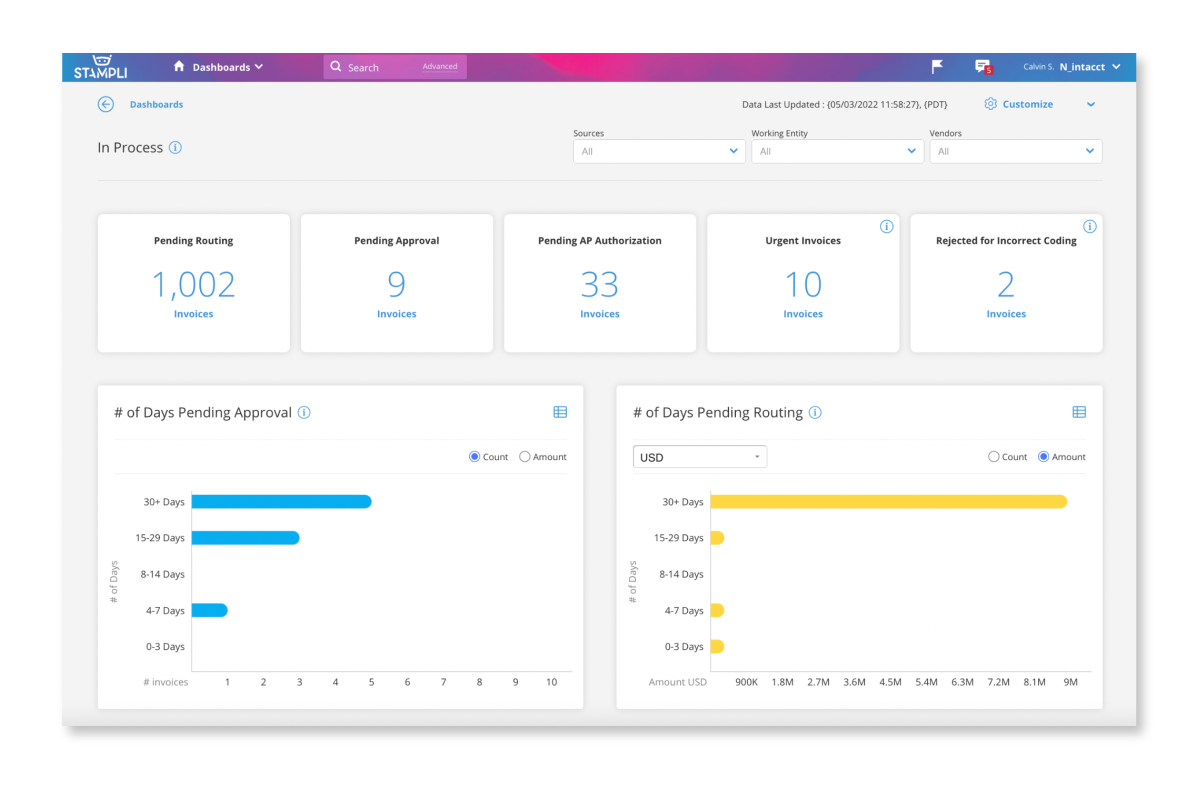
AP user productivity dashboard
The AP user productivity dashboard measures employee productivity and workload metrics such as approval times and total invoices processed or routed. We can use it to manage employee performance and identify opportunities to increase processing efficiency.
For example, if a specific employee is falling behind on processing times, we can look closer at their workload to see how we can improve the situation. Similarly, the AP user productivity dashboard also helps us improve approval times.
If an approver is taking a long time to approve invoices, we can look at ways we can improve their turnaround time, such as ensuring invoices are verified before being sent for approval or authorizing additional approvers.
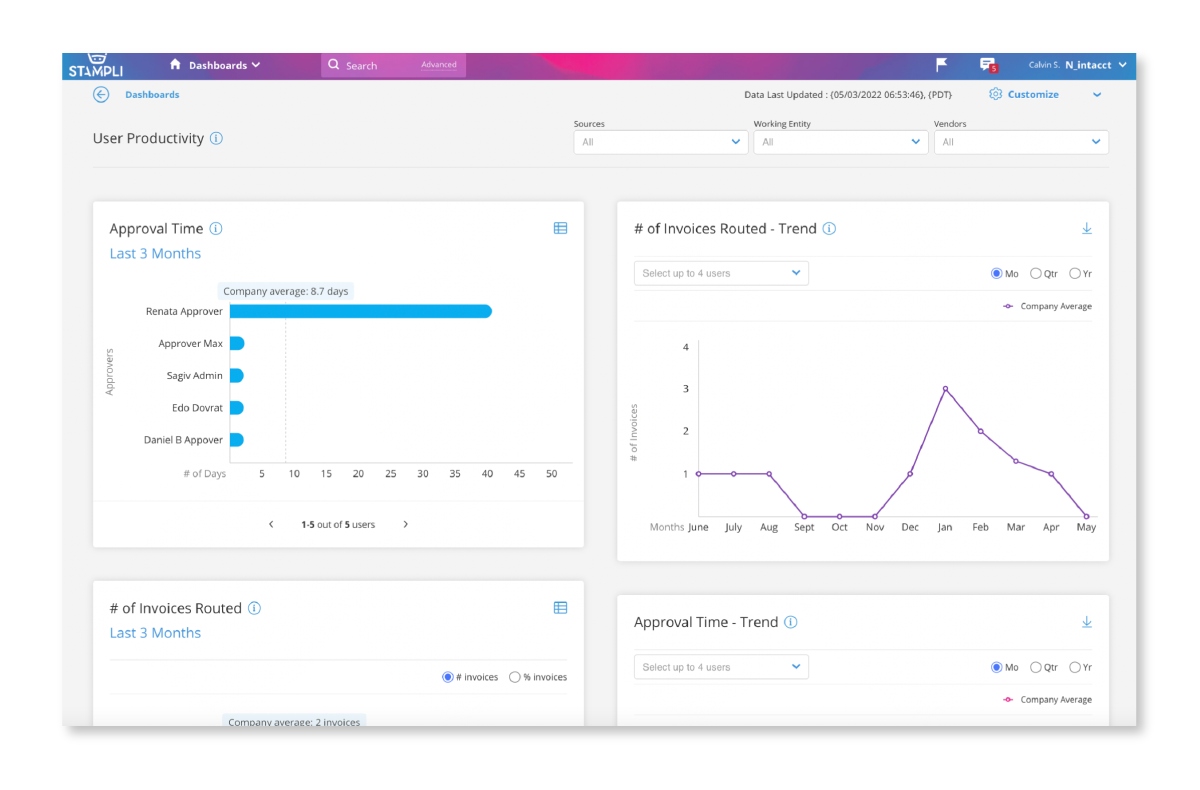
While different types of AP dashboards show different information, they share some common features that make them invaluable tools for our AP department:
Customization
We can customize AP dashboards to different user roles to ensure the dashboard shows the most valuable information to each user. For example, as the CFO, I prefer a big-picture view of AP performance, while our Accounts Payable manager is more interested in graphs showing process efficiency and employee performance. Best of all, we can save our customized dashboard templates so other employees can use them.
Automated reporting
Users can set up and save recurring reports in each dashboard and share the dashboards with other people in the organization.
Drill-down analysis
We can use filters and drill-down functionality to dig into and investigate our data. For example, we can view data by category, vendor, time period, or location for a more detailed picture.
Data export
Users can save data and export it to an ERP, accounting software, spreadsheet or other application for further study.
Choosing the right AP dashboard
An AP dashboard is a central element of AP automation, and it’s worthwhile to consider these questions when looking at automation solutions:
- What types of reports does the solution offer out of the box?
- What are the solution’s search capabilities?
- Can I download invoices based on certain criteria? Are invoices available in searches?
- Can the solution provide visual insights and analytics on my invoice lifecycle?
Automating and optimizing your AP processes improves vendor relationships, helps you control cash flow, and saves time and money. Adding AP dashboards to the mix transforms accounts payable into a strategic advantage.
Strategic Accounts Payable reporting with Stampli Insights
Stampli’s end-to-end Accounts Payable automation solution gives you full control and visibility over all your corporate spending, all in one place.
Get full visibility into your Accounts Payable data with Stampli Insights. You can have total visibility with Stampli Dashboards – built directly into the most powerful AP Automation solution – to understand invoice processes, employee workloads, invoice status, and more. Stampli Insights works right out of the box with no need for coding or IT support, and it provides key metrics and KPIs in real time.
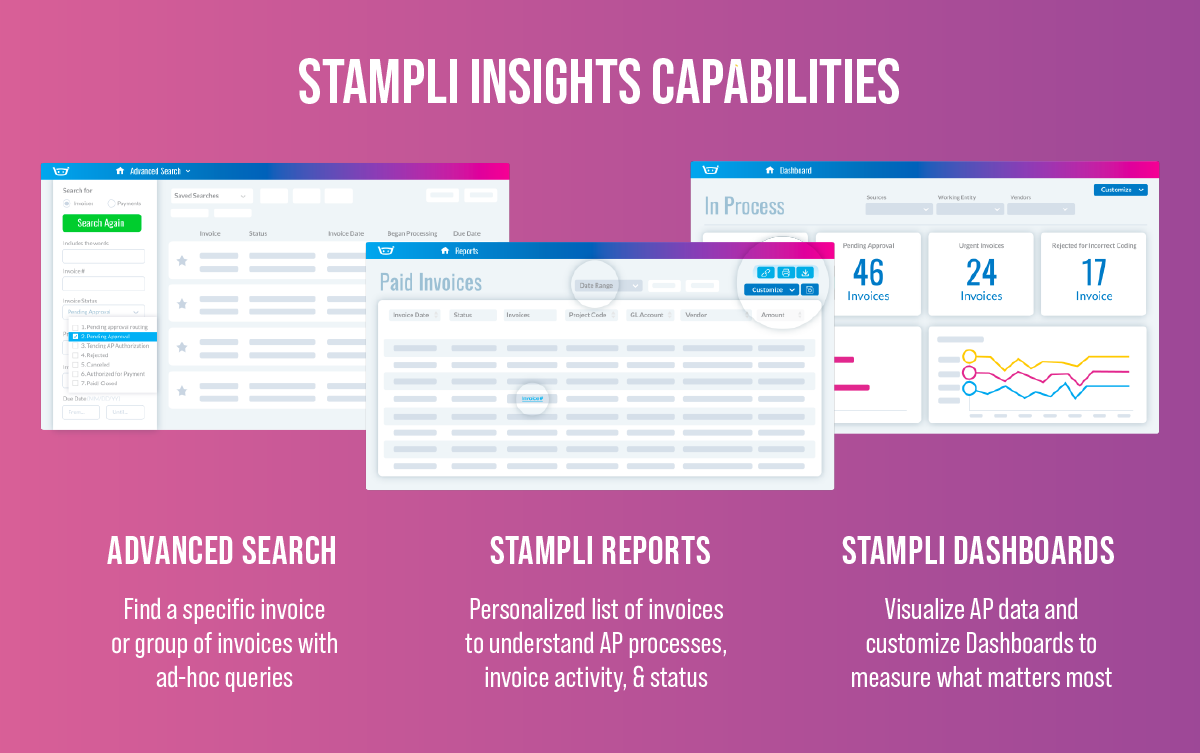
Here’s how Stampli Insights can help you turn AP into a strategic driver:
Visualize Accounts Payable data with Stampli Dashboards
Obtain comprehensive insights into the most valuable data and make informed decisions by leveraging Stampli’s three pre-built dashboards and interactive widgets:
- In Process: Visualize where invoices are in the lifecycle, assess bottlenecks, and review invoices by amount.
- Invoice Lifecycle: Streamline invoice processing by analyzing invoices over time, the time it takes to process, and why invoices are rejected.
- User Productivity: Maximize AP team efficiency by understanding workloads and the time it takes to accomplish tasks.
Drill Down into AP Data
Customize Stampli Dashboards to your specific needs by applying filters, adjusting widget order, setting a date range, viewing different data values, and more for a comprehensive view of your data.
- Filter KPIs and Widgets by source, working entity (subsidiary or company), vendors, and other key metrics.
- Customize Dashboard views by reordering widgets and viewing different data values, such as invoices handled by certain users and invoices with different currencies.
- Slice-and-dice underlying data to unearth exact invoice information.
Customized Invoice Views with Stampli Reports
- Generate 10 built-in AP reports effortlessly, providing detailed invoice information
- Create and save custom reports for convenient future access
- Share your reports with your team in CSV, XLSX, PDF formats, or print them out for added convenience
Advanced Ad-Hoc Search Queries
- Quickly access information on specific invoices and payments using our built-in search engine
- Refine search results with specific criteria, including invoice status, vendor, PO, or category
- Create and save custom searches through our user-friendly interface
Discover how Stampli can streamline your AP processes and help your business save time and money. Contact us today to learn more about the strategic benefits of instant insights into your AP data.